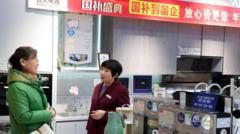The Chinese government has expanded its trade-in initiative to include kitchen appliances such as microwave ovens, dishwashers, rice cookers, and water purifiers, offering discounts of up to 20%. This move is set against a backdrop of economic challenges faced by the country, including a notable downturn in consumer demand and ongoing issues within the property market.
To support these programs, the government has allocated 81 billion yuan (approximately $11 billion or £8.9 billion) for consumer goods trade-ins this year. The State Council, China’s top economic planning authority, claims that the trade-in schemes, which began in March, have already yielded "visible effects." The Ministry of Commerce has noted that these policies have successfully stimulated sales of larger consumer goods, including home appliances and cars.
However, economists are skeptical about the long-term effectiveness of these measures in significantly boosting overall consumer consumption. Harry Murphy Cruise, a prominent economist at Moody’s Analytics, remarked on the mixed success of these initiatives, recognizing that while there has been a lift in sales for specific categories, the broader impact on consumer spending remains to be seen.
As part of a comprehensive strategy to bolster domestic consumption, China has been implementing various economic support measures amidst external challenges such as rising tariffs and a competitive global market. With anticipation surrounding the upcoming announcement of 2024 economic growth figures, which Chinese officials expect to be around 5%, the government continues to underline the importance of stimulating consumer spending for a resilient economic recovery.
To support these programs, the government has allocated 81 billion yuan (approximately $11 billion or £8.9 billion) for consumer goods trade-ins this year. The State Council, China’s top economic planning authority, claims that the trade-in schemes, which began in March, have already yielded "visible effects." The Ministry of Commerce has noted that these policies have successfully stimulated sales of larger consumer goods, including home appliances and cars.
However, economists are skeptical about the long-term effectiveness of these measures in significantly boosting overall consumer consumption. Harry Murphy Cruise, a prominent economist at Moody’s Analytics, remarked on the mixed success of these initiatives, recognizing that while there has been a lift in sales for specific categories, the broader impact on consumer spending remains to be seen.
As part of a comprehensive strategy to bolster domestic consumption, China has been implementing various economic support measures amidst external challenges such as rising tariffs and a competitive global market. With anticipation surrounding the upcoming announcement of 2024 economic growth figures, which Chinese officials expect to be around 5%, the government continues to underline the importance of stimulating consumer spending for a resilient economic recovery.




















